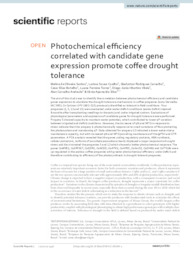Photochemical efficiency correlated with candidate gene expression promote coffee drought tolerance.
Photochemical efficiency correlated with candidate gene expression promote coffee drought tolerance.
Author(s): SANTOS, M. de O.; COELHO, L. S.; CARVALHO, G. R.; BOTELHO, C. E.; TORRES, L. F.; VILELA, D. J. M.; ANDRADE, A. C.; SILVA, V. A.
Summary: The aim of this study was to identify the correlation between photochemical efficiency and candidate genes expression to elucidate the drought tolerance mechanisms in coffee progenies (Icatu Vermelho IAC 3851-2 x Catimor UFV 1602-215) previously identified as tolerant in field conditions. Four progenies (2, 5, 12 and 15) were evaluated under water-deficit conditions (water deficit imposed 8 months after transplanting seedlings to the pots) and under irrigated system. Evaluations of physiological parameters and expression of candidate genes for drought tolerance were performed. Progeny 5 showed capacity to maintain water potential, which contributed to lower qP variation between irrigated and deficit conditions. However, the increases of qN and NPQ in response to stress indicate that this progeny is photochemically responsive to small variations of am protecting the photosystem and maintaining qP. Data obtained for progeny 12 indicated a lower water status maintenance capacity, but with increased qN and NPQ providing maintenance of the PSII and ETR parameters. A PCA analysis revealed that the genes coding regulatory proteins, ABA-synthesis, cellular protectors, isoforms of ascorbate peroxidase clearly displayed a major response to drought stress and discriminated the progenies 5 and 12 which showed a better photochemical response. The genes CaMYB1, CaERF017, CaEDR2, CaNCED, CaAPX1, CaAPX5, CaGolS3, CaDHN1 and CaPYL8a were up-regulated in the arabica coffee progenies with greater photochemical efficiency under deficit and therefore contributing to efficiency of the photosynthesis in drought tolerant progenies.
Publication year: 2021
Types of publication: Journal article
Unit: Embrapa Coffee
Observation
Some of Embrapa's publications are published as ePub files. To read them, use or download one of the following free software options to your computer or mobile device. Android: Google Play Books; IOS: iBooks; Windows and Linux: Calibre.
Access other publications
Access the Agricultural Research Database (BDPA) to consult Embrapa's full library collection and records.
Visit Embrapa Bookstore to purchase books and other publications sold by Embrapa.

